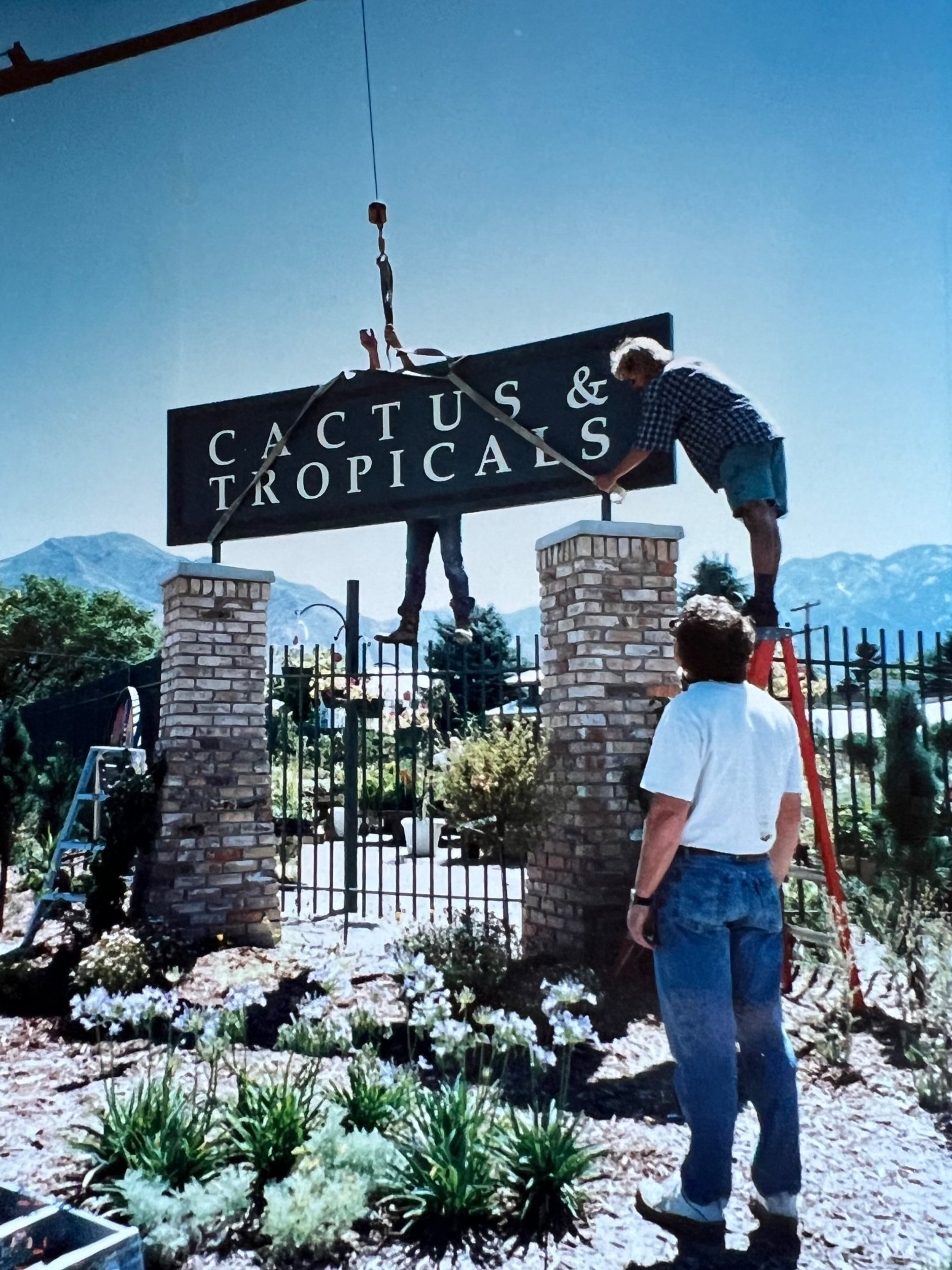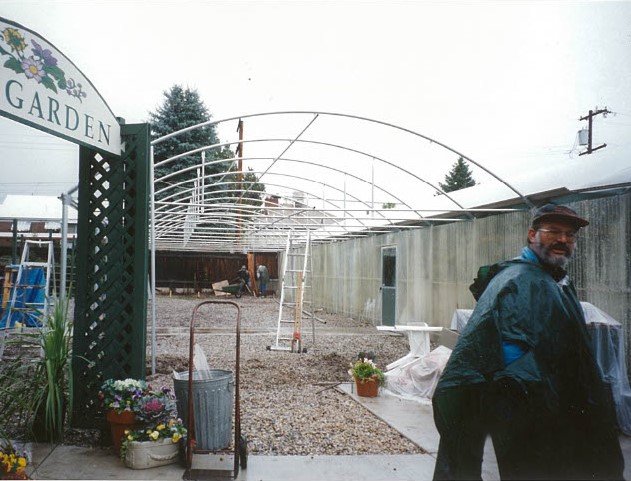The Greenhouse Odyssey: Nineteen-Out of Gas but Still Running
By Lorraine Miller
No sooner had the Secretary of the Treasury, Lloyd Benson said goodbye at the greenhouse door, than the owner of the gas station next to the new office, came knocking. Her family owned a very old Pyramid gas station and car garage on the NE corner of Twenty-seventh South and Twentieth East. It was never in my periscope to own the corner, so I hadn’t paid attention to who owned it. I assumed that Wayne, the auto mechanic, did.
The real gas station owner introduced herself and told me she was on a fishing expedition. Okay, I’ll bite! When I added the word ‘Tropicals’ to our business name, people called to see if I sold guppies. Maybe this was more of the same. But no, it wasn’t. She explained Wayne’s lease was up. Her family didn’t want to renew it.
They didn’t want the gas station either. What they wanted was OUT. Did I want to buy it?
My heart instantly went out to Wayne. I thought I knew exactly what he was feeling since I had experienced the same thing when the Board of Education took the Grass Menagerie property through eminent domain. I was sure if he was told his lease would not be renewed, he wasn’t feeling good. He was feeling sunk.
I walked over to talk to him about it, and I was surprised to see he was in a much better place than I expected. Apparently, he’d known for a while that he would have to move. He had a new place in mind, and it was practically kitty-corner from his current location. He was working on the deal and looking forward to moving. That took a big load off my mind and heart.
I turned my thoughts to two separate issues: buying and owning the gas station. Let’s take ownership first. Adding the corner lot to the other three would be life-changing for Cactus & Tropicals. It would be a windfall in two ways. Most retail businesses benefit from a corner location. Visibility isn’t just doubled, it’s quadrupled!
Whoever coined the phrase, ‘location, location, location,’ should have followed up by saying, ‘visibility, visibility, visibility.’
For Cactus & Tropicals that meant open fencing, dazzling corner signage, an eye-catching gazebo, arbors, lots of color, lots of plants, lots of attraction.
Maybe a pond. We could change our name to ‘Cactus & Tropicals and Annuals and Perennials and Shrubs and Trees and Bulbs.’ Where does it end?
The other bonus in owning the corner was that this lot was bigger than the others. Because the property lines in the neighborhood originally followed the path of early irrigation ditches, the lot was ten feet wider and twenty-five feet deeper. The extra space would be critical in growing the business. It allowed for the addition of one more greenhouse and the creation of a true delivery entrance. I’ll just go ahead and call it Shipping and Receiving. It would be entered from Twenty-Seventh South. As it was, deliveries, including semi-trucks, had to be unloaded in the parking lot on Twentieth East. We tried to schedule our deliveries early in the morning, before customers arrived. But that was almost impossible. A semitruck with a load of plants from Florida shows up when it shows up. A receiving entrance in the rear would prevent customers from being blocked or trapped in the parking lot.
Purchasing the gas station was a different side of the equation. It had only been two and a half years since I refinanced my original loan. No matter how supportive my banker had been, I wasn’t sure he’d want to refinance again.
Time to be clear-eyed about what a project of this size would entail financially: the purchase price, extensive demolition, removal of gas tanks and gas pumps requiring environmental studies, construction of new buildings, arbors, sidewalks, plant benches, fencing, signage, and more pavement. The deal was complicated by the possible environmental issues. How would it be remediated? Who would pay for it? How much does something like that cost? It was staggering. Another way of saying, “Forge Ahead” is Where There’s a Will, There’s a Way. My banker, Richard Gray, was willing and now I had a way..
As the project moved forward, a timeline would be developed, but first things first, Wayne had to be resettled. He had to get rid of roughly twenty-five cars that wouldn’t start or steer. There were barrels of oil and sludge, stacks of tires, piles of dirty rags and plastic bottles. Luckily, I didn’t have to worry about how he would accomplish this. That was between him and the property owners.
Before demolition could begin, the hoists and racks and all things metal, four gas pumps above ground and four storage tanks below had to be removed. The storage tanks were drained and ever-so-carefully, lifted out of the ground and placed on flatbed trucks. All kinds of wiring and hosing of every caliber ran in every direction. Each one had to be followed to its end. That would take several days. A large bashing machine and dump truck after dump truck, dozens of them, carried away smashed concrete and broken bricks, including the gas station office and the adjoining four car garage. As it came down, we discovered the gas station had literally been built on the concrete foundation of an old home. There was a brick wall running all the way along the south side of the property, separating the gas station from the office property. That had to be demolished, to.
When the final chunks of concrete were cleared away, the entire property had to be enclosed in a ten-foot-high chain link fence. A private environmental company performed the EPA tests to check for contamination of soil or water. Since the gas station was likely built in the late 1940’s, a lot of people predicted the old tanks had leaked and dribbled gas down Twenty-seventh South. But there were no obvious holes or leaks in the tanks. That was a relief but, there could still be dangerous pinprick sized holes. The empty space was filled with soil, pipes and vents and various scientific devices. The test took a few months.
While the disappeared gas station was taking its breathalyzer test, and the property was thoroughly wrapped in chain link. Mayo and I and a few members of the nursery staff worked on the design of the new garden space, laying out sidewalks, designing a gazebo/service counter, arbors, pergolas and shade structures.
Where shopping carts may have lined up, ten shiny, red Radio Flyer wagons stood ready to carry a flat of pansies or a pot of petunias. Out of gas but still on the fly!




